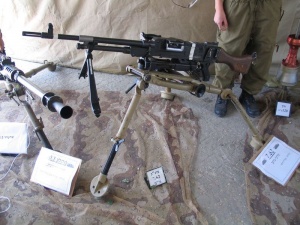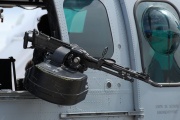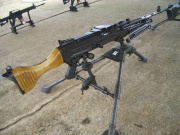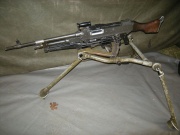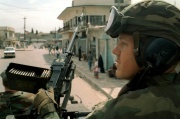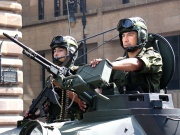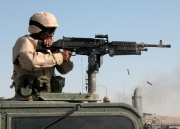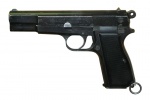Difference between revisions of "FN MAG"
(→External links) |
m (1 revision) |
Latest revision as of 15:26, 15 March 2013
| |||||||||||||||||||||||||||||||||||||||||||||||||||||||||||||||||
The MAG is a Belgian 7.62 mm general purpose machine gun, designed in the early 1950s at Fabrique Nationale (FN) by Ernest Vervier. It is used by almost 70 countries, in 25 of those countries it is a standard-issue support weapon, it was produced locally in 7 countries (Argentina, Egypt, India, Singapore, Taiwan, USA and the United Kingdom). The weapon’s name is an abbreviation for Mitrailleuse d`Appui Général[2] – "general purpose machine gun" (GPMG). The MAG is available in three primary versions: the standard, heavy infantry Model 60-20 machine gun, the Model 60-40 coaxial machine gun for armoured fighting vehicles and the Model 60-30 aircraft variant.
Contents |
[edit] Design details
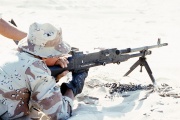
The MAG Model 60-20 is an automatic, air-cooled, gas-operated weapon that uses ignited powder gases vented through a port in the barrel to propel a gas piston rod connected to the locking assembly (it uses a short-stroke piston system). The barrel breech is locked with a vertically-tilting, downward locking lever mechanism that is connected to the bolt carrier through an articulated joint. The locking shoulder and camming surfaces that guide the locking lever are located at the base of the receiver. The MAG uses a series of proven design concepts from other successful firearms, for example the locking mechanism is modeled on that of the Browning M1918 (BAR) automatic rifle, and the feed and trigger mechanisms are from the WWII-era MG42 universal machine gun.
The MAG fires from an open bolt. Both the spring-powered extractor and ejector are contained in the bolt. After firing, spent cartridge casings are removed through an ejection port located at the base of the receiver (a spring-loaded dust cover of the MG42 type covers the ejection port). The machine gun has a striker firing mechanism (the bolt carrier acts as the striker as it contains a channel that houses the firing pin, which protrudes out from the surface of the bolt upon firing), an automatic-only trigger assembly and a manual cross-bolt push-button safety, which is located above the pistol grip. With the safety placed in the “safe” setting, the sear mechanism is disabled. The safety can only be engaged with the weapon cocked.
The weapon feeds from the left-hand side from open-link, metal ammunition belts: either the American disintegrating M13 belt (NATO standard) or the segmented German DM1 belt, whose 50-round sections can be linked together through a cartridge. In order to adapt the weapon to feed from one belt type to the other, several components of the feed mechanism need to be reconfigured since the position of the feed tray's cartridge stop and pawl angles in the top cover are different. The MAG features a pawl-type feeding mechanism that continues to move the feed link during both the rearward and forward cycles of the reciprocating bolt carrier, producing a smooth belt flow. The feeding mechanism’s three pawls are actuated by a roller connected to the bolt carrier. The feed channel rail, feed link, both feed slides and the feed tray are chrome plated. The top cover body is an anodized aluminum casting. In the infantry assault role, the weapon can be fitted with a sheet metal container that houses a 50-round belt and is attached to the left side of the receiver.
The quick-change barrel has a slotted flash suppressor. The barrel’s chamber and bore are chromium-lined and the barrel has 4 right-hand grooves with a 305 mm (1:12 in) rifling twist rate. Also attached to the barrel is the front sight base, carry handle and gas block (equipped with an exhaust-type gas regulator valve with three settings).
The machine gun is fitted with a folding bipod (attached to the end of the gas cylinder) that cannot be adjusted for height. The aluminum legs can be folded back for carrying or use as a forearm — and secured in slots under the receiver by their hooks and a spring-loaded catch. When firing from the hip, the bipod legs remain extended and the left leg is gripped for support. The bipod can be removed from the gas cylinder by tapping-out a roll pin in the gas cylinder head until it's flush and the bipod can be rotated enough to clear the gas cylinder's retaining lugs. The MAG is also equipped with a fixed wooden stock, pistol grip, carrying handle and iron sights that consist of a forward blade (adjustable mechanically for both windage and elevation) and a folding leaf rear sight with an aperture in the down position for firing distances from 200 to 800 m in 100 m increments and an open U-notch for ranges from 800 to 1,800 m graduated every 100 m. The rear sight is hinged to a base with protective ears that is integral with the receiver's upper forging.
The MAG’s receiver is constructed from sheet metal stampings reinforced by steel plates and rivets. The front is reinforced to accept the barrel nut and gas cylinder which are permanently mounted. Guide rails that support the bolt assembly and piston extension during their reciprocating movement are riveted to the side plates. The bolt's guide rails are shaped downward to drive the locking lever into engagement with the locking shoulder — also riveted to the side plates. The rear of the receiver has been reinforced and slotted to accept the butt-stock.
In the static machine gun role the weapon is mounted on a tripod that offers a higher degree of accuracy and control than the bipod, for example the FN 360° tripod, which features an elevation adjustment mechanism that enables the weapon’s bore axis to be maintained from 300 mm (11.8 in) to 600 mm (23.6 in), has a -30° to +15° elevation change and a 360° traverse range.
The vehicle-mounted variant of the MAG lacks a stock, bipod, carry handle, pistol grip and ejection port dust cover, it does however have a new closed-type gas regulator. Depending on the weapon’s employment, the machine gun can also be fitted with an extended charging handle linkage, standard trigger group (with a pistol grip), or a specialized trigger assembly with an electrically-fired trigger.
The pintle-mounted aircraft model is fed from either the right- or left-hand side exclusively with the M13 belt. Thus configured weapons typically lack standard iron sights and are equipped with electrically powered triggers.
The MAG fires the 7.62x51mm NATO cartridge. A variant was also produced for the Swedish Army (designated the Ksp 58), that was adapted to use the 6.5x55mm Mauser rifle cartridge.
[edit] Variants
In 1961 the Royal Small Arms Factory, Enfield—now British Aerospace—in the United Kingdom, undertook license production of the MAG in the following versions: L7A2, L8A2, L37A2, L20A1 and the L43A1. These models all use the M13 ammunition belt.
The L7A2, general purpose machine gun, replaced the L7A1 in service with the British Army. Compared to the MAG Model 60-20, it features, among other minor changes, a 10-position gas regulator valve, a plastic butt-stock and a bracket—used to mount optical day- and night-vision sights—mounted to the left side of the receiver. In a stationary defensive role the L7A2 can be mounted on the L4A1 tripod in conjunction with a periscope sight.
The L8A2 coaxial tank machine gun (replaced the L8A1) has a different gas valve switch (closed, single-position)—when compared to the analogous Model 60-40—a different flash hider and a modified cocking handle. The weapon also has a trigger group that accepts electrical input and a lever in the feed tray that enables the belt to be removed without lifting the feed tray cover.
Another tank machine gun is the L37A2 (succeeded the L37A1) designed to be mounted on tank turrets, in the commander's position, on wheeled armoured vehicles and on armored personnel carriers. It differs from the L8A2 primarily in its trigger, which was adapted from the L7A2 GPMG. The machine gun can be used in the ground role for self-defense, by dismounted vehicle crew members, the egress kit consists of an L7A2 barrel, bipod and buttstock.
The L20A1 aircraft machine gun was based on the L8A2, from which it differs by having an electrical trigger and a slotted flash suppressor. The L20A1 can be converted to right-hand feed by changing several components in the feed mechanism.
The L43A1, also developed from the L8A2, is a coaxially-mounted tank machine gun used to sight-in the vehicle’s main gun by firing ballistically-matched tracer ammunition at the target to confirm the trajectory visually. The weapon’s barrel, fitted with a flash hider, has a reinforced and heavier structure that increases the weapon’s accuracy especially during sustained fire.
On January 14 1977, the US Army awarded a contract to FN Herstal for the delivery of a modernized Model 60-40 variant tank machine gun designated the M240. Initially the firearms were produced in Belgium. Currently they are manufactured in the USA by FN’s US wholly-owned subsidiary FNMI (FN Manufacturing Inc.) located in Columbia, South Carolina. The M240 is built in several versions: the M240 (base model), M240C, M240E1, M240D, M240G and M240B.
The M240 is the standard coaxial machine gun used by US armored vehicles. It is used in the M60 series of tanks (where it replaced the M73/M219 7.62 mm machine guns) and the M1 Abrams family. It has an electrically-operated trigger and a reloading lever. Compared to the MAG Model 60-40, the M240 has a different flash hider and gas valve.
The M240C is a variant of the original M240, but with a right-hand feed system. It is used in the M2 and M3 Bradley series of infantry fighting vehicles as a coaxial gun to the main armament.
The M240E1 model, installed since 1987 on LAV-series wheeled armored fighting vehicles, has a spade-type grip with an integral trigger and cocking mechanism.
The M240D is considered to be an upgrade of the M240E1 and is optimized for use in military helicopters in a pintle-mounted configuration. The M240D is also supplied with a kit for dismounted use.
The M240G general purpose machine gun was introduced into service with the United States Marine Corps and the 75th Ranger Regiment in the early 1990s in place of the M60E3. It has a different gas adjustment valve and shorter flash hider than the MAG Model 60-20. The weapon was also modified to accept optical sights through the use of a MIL-STD-1913 receiver-mounted rail. The M240G is used on the M122A1 tripod for stationary use. It weighs 10.99 kg (24.2 lb), has an overall length of 1,245 mm (49.0 in) and a rate of fire of 650–950 rounds/min.
The M240B is a modernized and product-improved derivative of the M240G, which features a perforated hand-guard and heat shroud, a MIL-STD-1913 rail integral with the receiver top cover—that enables the use of optical day and night sights—a new synthetic stock and a new ammunition container. It was selected to be the Army’s new medium machine gun on December 1 1995, replacing the M60 machine gun (it defeated the M60E4 during trials). It weighs 12.5 kg (27.6 lb) and has a length of 1,245 mm (49.0 in). The rate of fire is 650 to 950 rounds/min.
[edit] FN Production Variants
| Designation | Description |
|---|---|
| MAG 60.20 | Standard infantry version with pistol grip, fixed buttstock, and bipod; Many subvariants including the T3 (L7A1) and T6 (L7A2) |
| MAG 60.30 | Fixed aircraft version, firing from a solenoid trigger; Capable, at least in some subvariants, of left and right hand feeding |
| MAG 60.40 | Coaxial version for armoured fighting vehicles; Many subvariants including the T3 (M240) |
| MAG 10.10 | "Jungle" version with shorter barrel and buttstock. |
[edit] British subvariants
| Designation | Description |
|---|---|
| L7A1 | 7.62x51 mm NATO FN MAG 60.20 T3 machine gun |
| L7A2 | L7A1 variant; FN MAG 60.20 T6; Improved feed mechanism and provision for 50 round belt-box |
| L8A1 | L7A1 variant; For mounting in AFVs. No buttstock. Barrel fitted with fume extractor. Solenoid-triggered, but with folding pistol grip for emergency use. |
| L8A2 | L8A1 variant; improved feed mechanism |
| L19A1 | L7A1 variant; extra-heavy barrel |
| L20A1 | L7A1 variant; for remote firing in gun pods and external mountings |
| L20A2 | L20A1 variant; improved feed mechanism |
| L37A1 | L8A1 variant; L8A1 breech & L7 barrel for mounting on AFVs. Conventional pistol grip & trigger, plus kit allowing dismounted use |
| L37A2 | L37A1 variant; L8A2 based. As above. |
| L43A1 | L7A1 variant; for use as a ranging gun on the Scorpion light tank |
| L44A1 | L20A1 variant; for Royal Navy |
[edit] Other families
The FN MAG has been adopted by nations around the world. In the British and American cases whole separate families of weapons have evolved from the original FN weapon.
[edit] Users
[edit] NATO
- Belgium: At use in every basic infantry and Paracommando squad of the Belgian Army.
- Canada: Used in the Canadian Forces with the designation the C6 GPMG[3], it is used primarily as a platoon level support weapon[4]. Two C6 machine guns are assigned to each Rifle platoon. The C6 GPMG is also mounted on a variety of vehicles, including the LAV III, the Coyote, the Leopard C2, and the G-Wagon LUVW. In these vehicles the C6 GPMGs are co-axially and pintle mounted and used to provide fire support to the infantry or for local defence of the vehicle itself.
- Estonia: The Swedish-made version known as the Ksp 58B has been adopted as the standard MG.[5]
- Greece: Army, Special Forces, Marines, Air Force, Coast Guard, Police
- Latvia: The Swedish-made version known as the Ksp 58B has been adopted by the national guard as the standard MG.[6]
- Lithuania: Uses the Swedish-made Ksp 58B.
- Netherlands: Mostly replaced in the infantry role by the FN Minimi, still widely used on tanks, AFVs (coaxial) and mounted on trucks and Jeeps. Recently a lot used on deployment in Afghanistan (RC-S) for additional support. Also used as a fixed weapon by non-combat units.
- Norway - In use on used Leopard 2 main battle tanks bought from Netherlands.
- Slovenia
- Spain: used in small numbers by the Spanish Air Force aboard Super Puma CSAR helicopters.
- Turkey
- United Kingdom: The L7 general purpose machine gun is used by the British Army.[7] It and the related L8 are a license-built derivative of the MAG. The official British Army designation for the current version is the L7A2 GPMG (General Purpose Machine Gun). The L7 was adopted by the British forces as a replacement for the long-serving Vickers machine gun (in the medium role) and the Bren (in the light assault role), following trials in 1957. Built under license originally by Royal Small Arms Factory, Enfield Lock and currently by Manroy Engineering,[8] it serves in the British Army, the Royal Marines and other services. There have been two main variants, the L7A1 and L7A2, developed for infantry use, with the L7A2 having superseded the earlier variant. Several other variants have been developed, notably the L8 (produced in the L8A1 and L8A2 versions), modified for mounting in armored vehicles (the L37 variant was developed for mounting on armored vehicles). Although intended to replace the Bren entirely, that light machine gun (re-titled as the L4) continued in use in jungle terrain (especially in the Far East), where there was no requirement for the medium machine gun role, and with secondary units, until the adoption of the L86A1 Light Support Weapon (LSW). The LSW was intended to replace both the L7 and the L4 in the light machine gun role, but dissatisfaction with the L86's sustained fire capabilities and reliability resulted in combat units continuing to utilize the L7 whenever possible (although neither it, nor its 7.62x51mm NATO ammunition were supposed to be issued to infantry platoons). The British Army and Royal Marines have since been issued with the L110A1 (FN Minimi Para) to replace the LSW as the light section support or fire support weapon. This uses the same NATO-standard 5.56x45mm ammunition as the L85 assault rifle. However 7.62 mm L7 variants continue to be used in both dismounted roles and mounted on some British military vehicles, naval vessels, and aircraft.
- United States - Replaced the M60 machine gun, The Army mainly uses the M240B, and the Marine Corps the M240G, though there are other types used by them and other branches, such as for use in AFVs. (see main article: M240 machine gun)
[edit] Non-NATO
- Argentina: The MAG is in use in the Argentine Army as the 7,62 Ametralladora Tipo 60-20 MAG[9] after being purchased more than two decades ago. The MAG saw action during the Falklands War. Argentinian MAGs were license-manufactured by the state-owned Dirección General de Fabricaciones Militares (DGFM) arsenal.[10][11] Also supplied to Bolivia.
- Australia: The MAG is officially designated as the MAG-58 within the Australian Defence Force, in particular, the Australian Army. Due to its weight the weapon is usually employed in the Direct Fire Support role mounted on a tripod for accurate sustained fire operations. The MAG-58 is also used as a coaxial and flex-mount machine gun for the ASLAV-25 AFV, and is also fitted to Army Blackhawk helicopters as a defensive weapon operated by the load master. Other vehicle uses of the weapon include the Land Rover Perentie 6x6 infantry mobility vehicles and the Bushmaster IMV vehicle. In recent times the stores of the MAG-58 of the ADF have undergone a complete rebuild replacing all the rivets in the receiver and exchanging L7 GPMG components that had found their way into ADF inventories over the years. Standardizing and refurbishing of the weapon platform allowed for continued operation and logistical support of the machine gun well into the year 2000 and beyond. To date, the MAG-58 remains the primary machine gun of the ADF with no replacement planned.
- Austria: The MAG is used by the Austrian Army as the 7,62 mm MG FNMAG/Pz and is used in the Schützenpanzer Ulan and the Kampfpanzer Leopard 2A4.[12][13] It's also used as the armament of the new S-70A-42 Black Hawk helicopters.[12]
- Bahrain
- Barbados
- Belize
- Bolivia: Acquired Argentinian-manufactured machine guns.
- Botswana
- Brazil: Standard support weapon of the Brazilian Army, known as the M971.[14]
- Brunei
- Burkina Faso
- Burundi
- Cambodia: Chinese made version of the FN MAG, the XY, 7.62 x 51, used by Khmer Republic and Khmer Rouge during the Cambodian Civil War and currently by the Royal Cambodian Army.
- Cameroon
- Chad
- China: Made for export as the CQ, 7.62 x 51 with an adjustable butt[15]. The XY, 7.62 x 51 is made with a wooden butt[15].
- Colombia
- Democratic Republic of the Congo
- Croatia
- Cuba
- Cyprus: National guard, navy, air force, police.
- Djibouti
- Dominican Republic
- Ecuador
- Egypt: Manufactured under license by Maadi Company for Engineering Industries[10] as the Helwan 920. Produced in bipod and tripod-mounted variants. One bipod-equipped variant has no stock and is fitted with spade grips.
- Gabon
- Gambia
- Ghana
- Guatemala
- Haiti
- Honduras
- India: The various services of the Indian Armed Forces use the locally produced versions of the MAG known as the MG 2A1, MG 1A, MG 5A and MG 6A. The machine guns are produced by the Small Arms Factory, Kanpur.
- Indonesia: The Pindad SPM2-V2 GPMG is a licensed Indonesian copy of the MAG.
- Ireland: Known as the GPMG or MAG 58.[16] It is used in a fire support role at section level in the infantry. Other units (including the Naval Service and Air Corps) use the GPMG in a variety of roles such as mounted, sustained fire and heavy roles. It has been recently introduced to the army reserve replacing the Bren gun.
- Israel: It is being superseded by the newer, Israeli-made Negev light machine gun. Still widely used on tanks, APC's, Israeli Navy missile boats and Dvora class fast patrol boat and others.
- Jamaica
- Jordan
- Kenya
- Kuwait: Uses both L7A2 & M240
- Lebanon: In use with the Lebanese Army & Internal Security Forces.
- Lesotho
- Libya
- Malaysia
- Mexico
- Morocco
- Myanmar
- New Zealand: The New Zealand Defence Force originally purchased the British-made L7A2 version of the MAG in 1976. These are now being replaced by several versions of the Belgian-made MAG-58, which was originally introduced into service as part of the introduction of the NZLAV. The FN-made MAGs are now used in the infantry light machine gun (LMG) role as a flexible mounted machine gun on the LOV and UH-1H and as a heavy sustained fire machine gun. [17]
- Nicaragua
- Nigeria
- Oman
- Pakistan
- Panama
- Paraguay
- Peru
- Philippines: Used on Simba APC.
- Qatar
- Rhodesia: Used by Rhodesian Security Forces during that country's Bush War
- Rwanda
- Saudi Arabia
- Seychelles
- Sierra Leone
- Singapore: Unlicensed production carried out by Ordnance Development and Engineering Company of Singapore[10], now integrated to ST Engineering. Two versions produced, one infantry assault variant fitted with a bipod, the other co-axial model for armored vehicle or vehicle mountings. One MAG is issued to each rifle platoon. It is always referred to as GPMG or simply - MG. The weapon is operated by the machine gun team, comprising the MG Commander, the MG-gunner, and assistant gunner who carries extra ammunition, helps link belts and change barrels, and provides security.
- South Africa: Deployed in infantry platoons. Commonly referred to as the LMG.
- South Korea
- Sri Lanka
- Sudan
- Suriname
- Swaziland
- Sweden: Adopted in 1958 as Ksp 58, and manufactured by Bofors Carl Gustaf.[18] It was chambered in 6.5x55mm Swedish. It was slightly modified in the 1970s, to the current Ksp 58B standard, with the major improvement being a new gas-regulator. At the same time most weapons were converted to 7.62x51mm NATO, by simply replacing the barrels. However, the old barrels were still kept to be able to use the large stock of ammunition in 6.5 mm. A short-barreled variant fitted with a telescopic metal stock similar to that of the Minimi Para was developed and designated the Ksp 58DF, but the resulting Ksp 58D has not yet been adopted. The Ksp 58 Strv is a coaxial version used in tanks. The Ksp 58C is used on the CV9040C of the Swedish Army.
- Switzerland
- Taiwan: Produced under license as the Type 74. Modified to Taiwanese specifications and manufactured by the 205th Armory, Ministry of Defense. It is based on the MAG but features extensive modifications to meet the requirements of the ROC Armed Forces. The Type 74 project was authorized by the ROC Army as a replacement for the Type 57/M60 machine guns.[19] The design was completed in 1985, and volume production commenced in 1988 after extensive testing. Several areas have been redesigned to optimize the weapon for local manufacturing capabilities and user requirements, particularly ergonomic measurements of the average Taiwanese soldier. The most obvious differences between the two are the M60-style bipod.[19] and enlarged trigger guard on the Type 74. Windage adjustment was also incorporated into the rear sight. The Type 74 barrel features spiral cooling fins similar to early MAG models, and retains the same quick-change system. The rate of fire was deliberately lowered to improve reliability and is adjustable between 400 and 800 rounds/min. A variant known as the Type 74V was developed as a coaxial machine gun for the M41D light tank upgrade. It did not enter production.
- Tanzania
- Thailand: In service with the Royal Thai Army as an infantry support and vehicle-mounted machine gun since 1995.
- Tunisia
- Uganda
- United Arab Emirates
- Republic of Upper Volta
- Uruguay
- Venezuela: The MAG is used as a standard machine gun in Venezuelan Army infantry units.
- Zaire
- Zimbabwe: Mainly stockpiles left over from the Rhodesian government.
[edit] Resources

This article or section is missing resources, such as diagrams or manual links, and could use more input to fill in the missing bits. You (yes, you!) can help Gunsopedia provide more comprehensive information to our users by using your own knowledge to add to it.
[edit] See also
- Mk 48 Mod 0 LWMG - FN MINIMI in 7.62 mm caliber for US SOCOM
- Sumitomo NTK-62 - an outwardly similar Japanese weapon
[edit] Notes
- ↑ Replacement cost per globalsecurity.org
- ↑ World Gun's FN MAG page. Retrieved on November 21, 2008.
- ↑ The Canadian Army - Equipment
- ↑ Canadian Forces General Purpose Machine-Guns. Retrieved on April 2, 2008.
- ↑ Eesti Kaitsevägi - Tehnika - Kuulipilduja KSP-58
- ↑ http://www.mod.gov.lv/upload/nbsfakti.anglu.gala.pdf
- ↑ army.mod.uk
- ↑ http://www.manroy.co.uk/manroy/GPMG.HTML
- ↑ MAG 7.62 being used in military training exercises in Misiones, Argentina
- ↑ 10.0 10.1 10.2 Multiplying the Sources. Retrieved on October 5, 2008.
- ↑ European arms exports to Latin America - An inventory. Retrieved on August 15, 2008.
- ↑ 12.0 12.1 7,62 mm Maschinengewehr FN MAG 58. Retrieved on April 2, 2008.
- ↑ Österreichs Bundesheer - Waffen und Gerät - Turmdachmaschinengewehr MAG (für Leopard A4)
- ↑ http://www.exercito.gov.br/01inst/armtmuni/metralha.htm
- ↑ 15.0 15.1 Popenker, Maxim & Williams, Anthony G., page 41.
- ↑ Army Weapons - General Purpose Machine Gun. Retrieved on April 2, 2008.
- ↑ Machine Guns.
- ↑ Medeltung kulspruta 58. Retrieved on October 9, 2008. (Swedish)
- ↑ 19.0 19.1 Taiwanese Machineguns.
[edit] References
- Popenker, Maxim & Williams, Anthony G. (2008). Machine Gun. The Development of the Machine Gun from the Nineteenth Century to the Present Day. London: Crowood Press. ISBN 978-1847970305.
[edit] External links
- FN Herstal official site
- Modern Firearms
- The Swedish Ksp 58 on the range
- Video of the Canadian C6 GPMG
- C6 tracer fire
- Canadians exercise with the C6
- Video of the L7A2 GPMG in British service
| This article is part of a series on FN Herstal firearms | ||
|---|---|---|
| Handguns | Barracuda · Five-seven · FNP series/FNX series · Forty-Nine · Hi-Power · HP-DA · M1900 · M1903 · M1905 · M1910 | |
| Rifles | Semi-auto & select — C1 · CAL · F2000 / FS2000 · FAL · FNAR · FNC · Model 1949 · PS90 · SCAR-L/SCAR-H Bolt-action — Model 1950 · Model 30-11 · PBR · SPR · TSR | |
| Shotguns | SLP · TPS | |
| Submachine guns | P90 | |
| Machine guns | BRG-15 · M2 · MAG· Minimi · Mle 1930 | |
| Other stuff | 5.56x45mm SS109 · 5.7x28mm · EGLM · FN 303 | |
